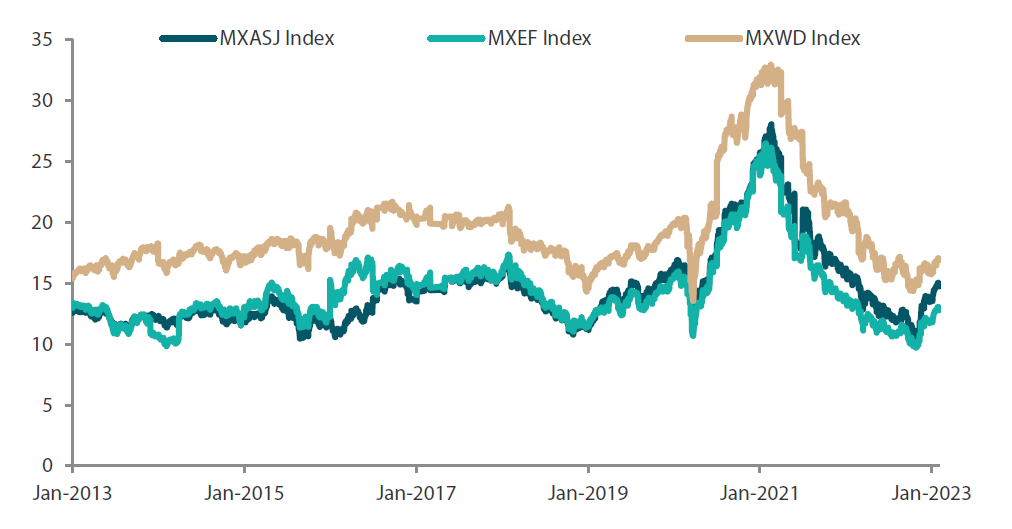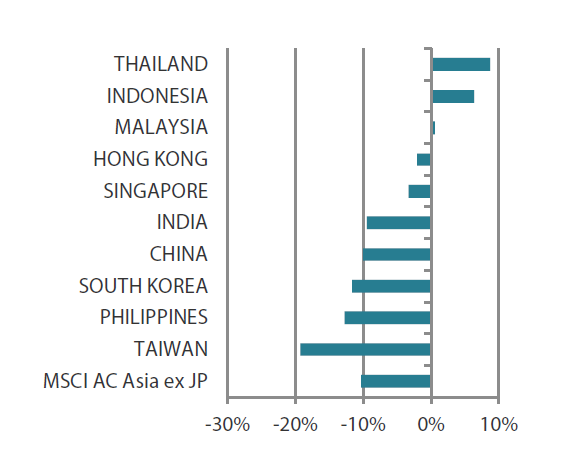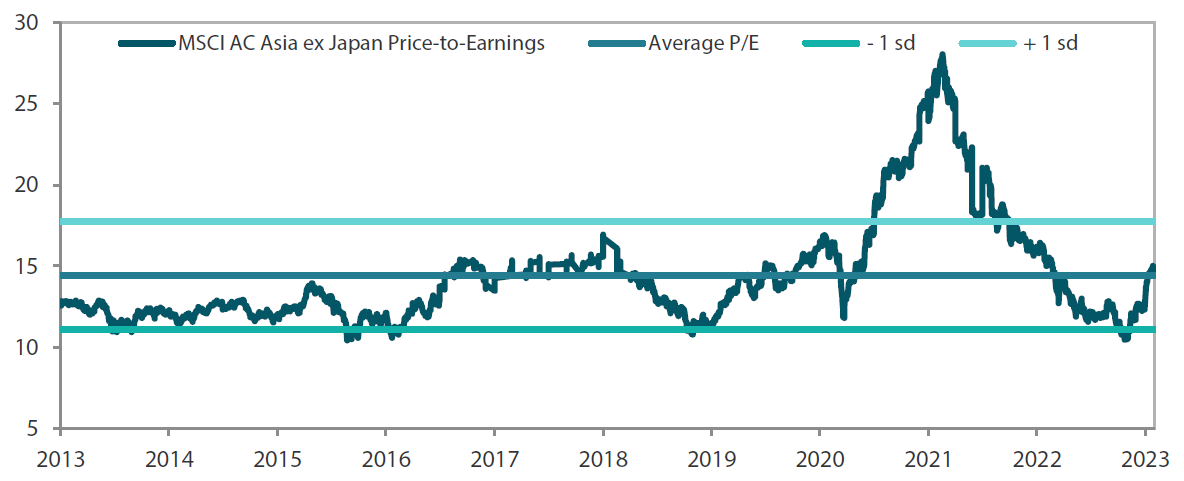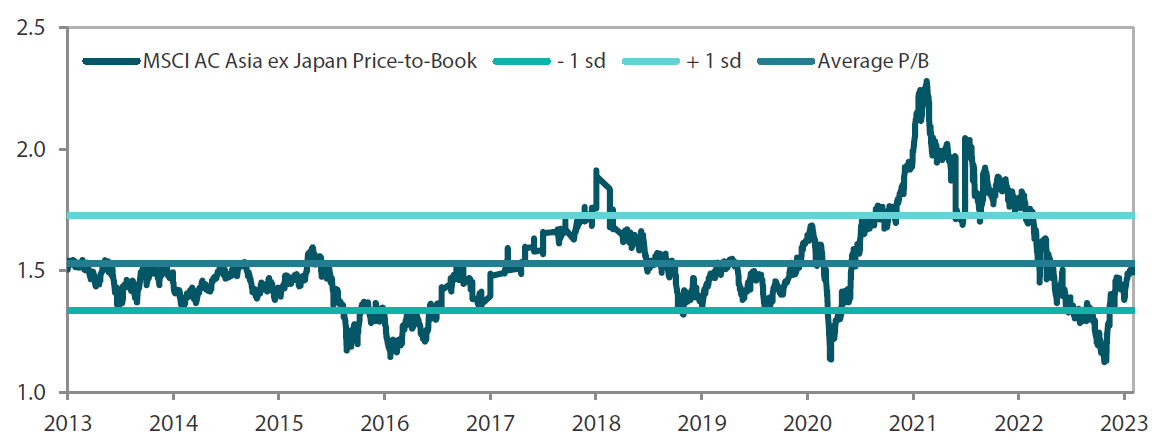Summary
- The MSCI AC Asia ex Japan Index made a strong start to 2023, returning 8.2% in US dollar (USD) terms in January. This was supported by a rebound in investor sentiment towards Chinese equities. Elsewhere, the US consumer price index (CPI) eased for the sixth straight month, spurring hopes that inflation pressures are starting to abate.
- China (+11.8%) extended its rally, as travel and consumption spending surged over the first Lunar New Year holiday since the country emerged from its zero-COVID slumber. Taiwan (+12.7%) and South Korea (+12.4%) were the region’s top performers in January, while Hong Kong climbed 3.8%. All ASEAN markets turned in positive returns for the month, whereas India underperformed its Asian peers, retreating 3.0%.
- For China, we retain a positive view on areas of consumption, in particular local brand leaders, and on areas of healthcare, software and select industrials. We have a more selective approach to investments in India, while we observe two important fundamental changes with long-term implications for sustainable returns in the ASEAN region.
Market review
Asian markets turn in strong gains
The MSCI AC Asia ex Japan Index made a strong start to 2023, returning 8.2% in US dollar (USD) terms in January. This was supported by a rebound in investor sentiment towards Chinese equities due to policy pivots in areas including COVID-19, housing and internet regulation. Elsewhere, the rise by the US consumer price index (CPI) eased for the sixth straight month, cooling to 6.5% year-on-year (YoY) in December 2022, spurring hopes that inflation pressures are starting to abate.
Chart 1: 1-yr market performance of MSCI AC Asia ex Japan vs. Emerging Markets vs. All Country World Index
 Source: Bloomberg, 31 January 2023. Returns are in USD. Past performance is not necessarily indicative of future performance.
Source: Bloomberg, 31 January 2023. Returns are in USD. Past performance is not necessarily indicative of future performance.
Chart 2: MSCI AC Asia ex Japan vs. Emerging Markets vs. All Country World Index price-to-earnings
 Source: Bloomberg, 31 January 2023. Returns are in USD. Past performance is not necessarily indicative of future performance.
Source: Bloomberg, 31 January 2023. Returns are in USD. Past performance is not necessarily indicative of future performance.
China, Taiwan and South Korea surge
In the North Asian region, China (+11.8%) extended its rally, as travel and consumption spending surged over the first Lunar New Year holiday since the country emerged from its zero-COVID slumber. Initial COVID-related jitters of reopening also eased after preliminary signs suggested that the virus outbreak could have peaked in several Chinese cities. China’s GDP growth in the fourth quarter of 2022 (4Q22) was better than expected, coming in at 2.9% YoY, while December economic activity data similarly beat expectations. Hong Kong climbed 3.8%, as it has officially reopened its border with mainland China, allowing travel under a quarantine-free arrangement.
Taiwan, the best performing regional market in January, jumped 12.7%, led by the bellwether electronics sector, especially large semiconductor stocks. During the month, shares of index heavyweight TSMC surged after it reported a 78% jump in 4Q22 net profits on the back of strong sales of its advanced chip sales. In South Korea, stocks rose 12.4% after the government and financial regulator announced plans to scrap several regulations in the local stock market within this year to make investment easier for foreign investors. The Bank of Korea raised interest rates by 25 basis points (bps) and issued statements indicating that inflation may be nearing a peak.
Reference to any particular security is purely for illustrative purpose only and does not constitute a recommendation to buy, sell or hold any security or to be relied upon as financial advice in any way.
All ASEAN markets in positive territory
In the ASEAN region, all markets posted positive returns for the month. Singapore led the ASEAN region, surging 7.5%, whereas the Philippines (+5.4%), Thailand (+3.8%), Indonesia (+3.3%) and Malaysia (+2.9%) turned in more subdued gains in January.
Singapore’s headline inflation eased to 6.5% YoY in December. The Philippine economy held up well, expanding 7.6% last year, as domestic consumption remained resilient despite soaring inflation. Thailand’s central bank stated that economic recovery is maintaining traction, helped by a rebound in tourism and domestic demand. Meanwhile, Indonesia saw its trade surplus hit a record high of USD 54.46 billion in 2022, while Malaysia’s central bank left benchmark interest rate unchanged at 2.75%, saying it will assess the impact of its previous policy adjustments.
Indian equities retreat
Elsewhere, India underperformed its Asian peers, retreating 3.0% in January, with the decline compounded by the selling pressure on Adani Group stocks during the last week of the month. Shares linked to Adani Group fell sharply after the conglomerate was accused by short seller Hindenburg Research of engaging in widespread stock price manipulation and money laundering. Separately, India's economy is likely to grow 7% in the current fiscal year, according to advance estimates.
Chart 3: MSCI AC Asia ex Japan Index1
| For the month ending 31 January 2023 | For the year ending 31 January 2023 | |

|

|
Source: Bloomberg, 31 January 2023.
1Note: Equity returns refer to MSCI indices quoted in USD. Returns are based on historical prices. Past performance is not necessarily indicative of future performance.
Market outlook
China remains the focus point
At present, we find ourselves sandwiched between the prospect of further tightening and potential recessions in the West and the re-opening momentum from China—the world’s second largest economy. China is now a bigger trading partner with most countries in Asia than both the US and the EU combined. Hence, for the time being, Asia’s prospects look relatively better and with valuations still largely depressed across most parts, we believe there are fertile opportunities to pick good long-term investments with both high potential sustainable returns and positive fundamental change. China remains the focal point at present, but we would expect that to permeate through the region to varying degrees as economic activity picks up.
Reference to any particular security is purely for illustrative purpose only and does not constitute a recommendation to buy, sell or hold any security or to be relied upon as financial advice in any way.
Retaining a positive view on China’s consumption, healthcare, software and select industrials
The pace of its re-opening together with a marked change in rhetoric and the stronger policy support for the property market have surprised many China watchers. Our next major clues on future policy direction for China are likely to come only in March. We note that many service-orientated industries in China have undergone consolidation through COVID-19, and early indications through the Lunar New Year period are that consumer demand is picking up strongly across some sub-segments. Significant excess savings were set aside last year and with property likely to remain for living rather than speculating, it will be keenly watched as to how Chinese households allocate their money. For now, we retain a positive view on areas of consumption, in particular local brand leaders, and on areas of healthcare, software and select industrials.
Elsewhere in North Asia, the more concerted efforts in South Korea to improve total shareholder returns and address longstanding foreign capital investment issues could be a significant change for the country’s equity market. In addition, with the potential improvement in China’s domestic economy and further digestion of inventories, there may be early indications of a bottoming out in parts of the technology cycle. We retain an upbeat view on healthcare contract manufacturers with an increasing focus on stock specific hardware technology opportunities.
A selective approach to India is warranted
While India may remain one of the highest growth economies in 2023, it is not where the immediate positive change is. That, together with already stretched valuations—particularly relative to other parts of Asia—warrants a more selective approach to India, in our view. In addition, the negative report by Hindenburg Research on the Adani Group is likely to cause some reassessment of both relative valuations and corporate governance in India as a whole. We would note, however, that this remains a fairly isolated example of leverage build-up in India and more broadly, credit origination has been fairly muted. India’s budget was balanced and looks to promote more capital expenditure in the country. As such, we would watch for better opportunities to allocate to one of the region’s best sources of sustainable returns and positive change.
Fundamental changes can be significant drivers of long-term returns in ASEAN
In ASEAN, which was another relative outperformer in 2022, we observe two important fundamental changes with long-term implications for sustainable returns. Firstly, there is increasing investment from the West looking to diversify and secure supply chains. This has been most widely taken up by Vietnam but increasingly by others too. The second important change is outbound Chinese investment resulting in foreign direct investment for several countries, most notably Indonesia at present, as the country looks to develop more downstream electric vehicle manufacturing. Both these fundamental changes can be significant drivers for the region over the long term. With the resumption of Chinese tourism, there will also be much needed revenue streams coming back to popular destinations like Thailand and Singapore.
Chart 4: MSCI AC Asia ex Japan price-to-earnings

Source: Bloomberg, 31 January 2023. Ratios are computed in USD. The horizontal lines represent the average (the middle line) and one standard deviation on either side of this average for the period shown. Past performance is not necessarily indicative of future performance.
Reference to any particular security is purely for illustrative purpose only and does not constitute a recommendation to buy, sell or hold any security or to be relied upon as financial advice in any way.
Chart 5: MSCI AC Asia ex Japan price-to-book

Source: Bloomberg, 31 January 2023. Ratios are computed in USD. The horizontal lines represent the average (the middle line) and one standard deviation on either side of this average for the period shown. Past performance is not necessarily indicative of future performance.



